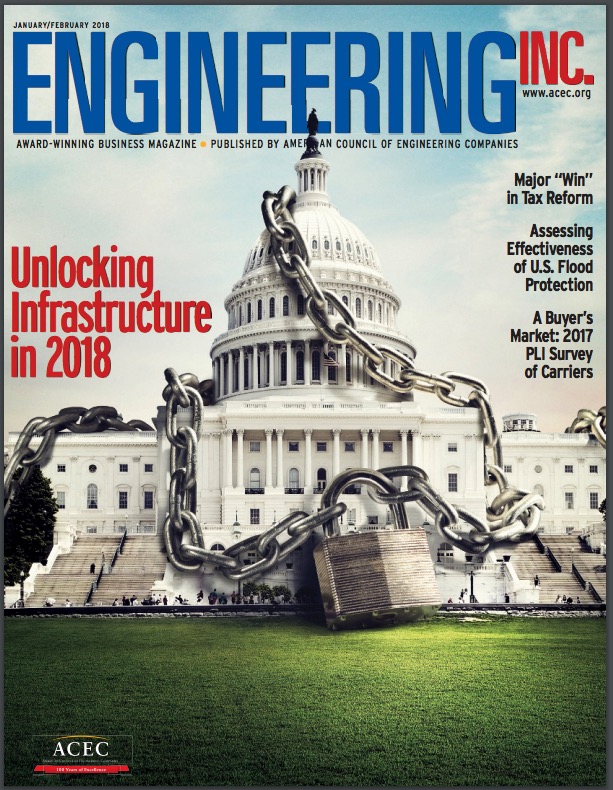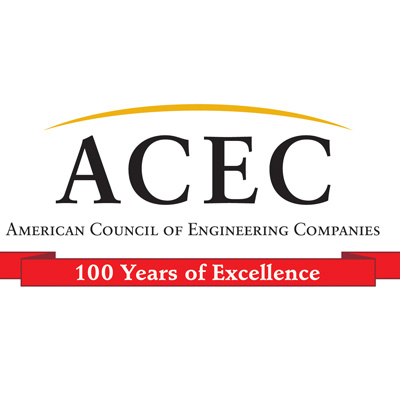AMERICAN COUNCIL OF ENGINEERING COMPANIES (ACEC)
Written by Samuel Greengard
Will 2016 Election Promises for Significant Infrastructure Investment Be Kept?
 Today’s political environment can be summed up in two, frustrating words: partisan gridlock. Aside from the year-end sprint to pass tax reform, it has become next-to-impossible to enact major legislation in several areas, including transportation, water infrastructure and energy. Expectations for 2018 nonetheless, remain high.
Today’s political environment can be summed up in two, frustrating words: partisan gridlock. Aside from the year-end sprint to pass tax reform, it has become next-to-impossible to enact major legislation in several areas, including transportation, water infrastructure and energy. Expectations for 2018 nonetheless, remain high.
Transportation Infrastructure
A 2016 report by the National Association of Manufacturers, showed the gap between current spending and what is needed to revitalize U.S. infrastructure—including highways and bridges, transit systems, aviation, ports and inland waterways—totals more than $1 trillion. ACEC has for years advocated for strengthening the long-term fiscal stability of the Highway Trust Fund, as the annual gap between Trust Fund revenues and annual expenditures is projected to grow to $20 billion by 2021.
The Council will continue working aggressively to advance a bold infrastructure investment program that includes robust funding for core federal programs, innovative financing mechanisms to promote additional private investment and measures to increase utilization of private sector engineering and design capabilities.
In early 2017, President Trump released a proposal to provide $200 billion in federal funds to leverage additional state, local and private sector investment as part of a proposed $1 trillion infrastructure plan to rebuild America. It focused on expanding private sector funding and promoting the use of public-private partnerships (P3s).
Congress, however, continues to wait on the White House for details of the president’s initiative. “There are fundamental questions about how we invest in ourselves,” says Rich McFarland, senior vice president at Parsons Corp. While some states and localities, including the state of West Virginia and the city of Los Angeles, have recently passed transportation initiatives, federal funding and oversight remain critical. “Obviously, maintaining national standards is critical for commerce and the economy. Interstate highways and many other projects don’t stop at state lines,” observes Cathy Connor, senior vice president and director of federal government affairs at WSP USA. In addition, many projects are too extensive and expensive for states or localities to tackle on their own. “You can’t leave everything up to state and local funding,” she says.
Greater state autonomy combined with President Trump’s call for the greater use of challenge grants also has some concerned that a clear set of winners and losers might emerge. Some states have resisted increases in their gas tax, others divert gas tax revenues into a general fund and still others lack ballot propositions that might address key transportation and infrastructure issues. Further complicating matters, 12 U.S. states still haven’t authorized any form of P3s—while the framework in states with P3s varies greatly.
A couple of bright spots have emerged. For example, the administration issued an executive order in August focused on facilitating more efficient environmental reviews, a long-held industry priority. The stated goal is to reach unified federal permitting decisions on major infrastructure projects within a two-year timeframe. “One way to accelerate, expedite and improve infrastructure and other large projects is to get rid of the red tape—without eliminating the underlying environmental protections. It’s important to have federal agencies conduct simultaneous National Environmental Policy Act environmental reviews rather than the process taking place sequentially,” Connor argues.
Even if lawmakers in Washington don’t agree on the specifics, there’s bipartisan agreement that it’s an issue that must be addressed now. Thomas O’Grady, corporate president for HNTB Corp., says he’s optimistic that a breakthrough will occur in the not too distant future. “The importance of infrastructure to the economy and the national well-being is clear,” he says.
Ports, Airports and FAA Reauthorization
Airport terminals, runways and other air and port infrastructure also require significant improvements. Many U.S. facilities and terminals require modernization, including the need for more advanced IT and security systems or just overall expansion to handle increased demand.
ACEC has steadfastly advocated for increased funding for the Airport Improvement Program, and the raising the cap on Passenger Facility Charges (PFC) collected by airports to finance infrastructure investments, as well as an expansion of Qualifications-Based Selection rules for airport projects. The Council last fall succeeded in lifting the Passenger Facility Charge cap in a pending Senate appropriations bill.
O’Grady says that we’re approaching a critical juncture where additional funding is desperately needed to meet air travel demands. “We’re not at the pinch point yet, but it’s clear there will be problems soon if we don’t see improvements to airport infrastructure,” he says. This includes land-side roadway access, people-mover systems and airfield capacity enhancements.
Today’s flight control infrastructure doesn’t necessarily take advantage of the latest technologies, says Jay Farrar, principal vice president and manager of the Washington D.C. office at Bechtel Corp. The FAA relies on terrestrial navigation systems—essentially radar technology introduced in the 1950s—instead of satellite systems. Some of the nation’s ports have also reached geographic constraints and have hit full capacity—or they are approaching critical levels. Many of them also cannot accommodate post-Panamax ships. “We must focus on how we can make ports and systems more efficient,” he says.
FAA reauthorization—which Congress tackles every four years—has entered the spotlight. Although Congress has approved an FAA extension to temporarily fund the agency at previous budgeting levels through the end of March 2018, a long-term funding agreement hasn’t been reached. The current bill, H.R. 2997 (the 21st Century AIRR Act), aims to fund improvements but also create a private nonprofit corporation to oversee air traffic controllers. The latter issue has led to acrimonious debate.
WSP’s Connor says that FAA reauthorization is vital. “This is an issue that has largely been overshadowed by all the controversy with the proposal to privatize the Air Traffic Control (ATC) system. The issue being discussed relates to the ATC system, not to the controllers,” she says. All of this has made it difficult for engineering firms to plan and operate adequately. Businesses in this industry require more certainty, she explains.
Taxes
Tax reform is the one major agenda item expected to become law early in 2018. The final bill appears to be a major win for the engineering industry, particularly for ACEC’s effort to secure tax benefits for firms of all sizes and tax structures.
The final tax plan will reduce corporate tax rates from the current 35 percent to 21 percent, which will help engineering firms organized as C corporations be more competitive in the global marketplace. The bill also preserves the ability of firms to use cash accounting versus undergoing the expensive process of switching to accrual accounting. And the final package maintains existing tax incentives for retirement and employee ownership, such as ESOPs, which were key industry priorities.
For firms organized as “passthrough” businesses—S corporations, partnerships and LLCs— where the taxes are paid through the filings of individual firm owners, the bill will create a new 20 percent deduction instead of a reduced tax rate. While the original House and Senate versions of the bill initially excluded many engineering passthrough firms from the proposed tax benefit (along with doctors, lawyers and other service industries), ACEC was successful in securing changes that will treat the industry the same as other non-service industries in qualifying for the new deduction. Like those industries, engineering passthrough owners with incomes below $315,000 for joint filers and $157,500 for individuals can claim the full deduction. Owners with higher incomes will be able to claim the deduction using rules similar to those that apply to the Section 199 deduction that many A/E firms claim.
Other changes included in the final tax bill— including the elimination of the Section 199 deduction, reductions in state and local tax deductibility, and changes in the application of the alternative minimum tax—will affect individual firm owners in different ways.
Infrastructure funding and finance is an area where tax reform fell short of expectations. Federal action here is long overdue. The ongoing push for lower taxes, resistance at the national level to increasing the federal gas tax and the distaste for toll roads have made it extraordinarily difficult to fund transportation and infrastructure upgrades. Infrastructure improvements are further complicated by a growing need for cybersecurity protections—particularly as smart cities and autonomous vehicles roll into the landscape.
There’s been no increase in the federal gas tax since 1993, and the introduction of hybrid and electric vehicles is making it harder to fund projects in the traditional way. While some states, such as Oregon, have studied and even tested mileage-based transportation taxing, and Congress included funding in the FAST Act in 2015 to support additional pilot projects, there’s still no consensus about how best to move forward, or when. “The question our country must answer is: How do we invest in our collective economic future to meet the needs of a population exceeding 300 million people?” McFarland says.
WSP’s Connor points out that more than 24 states have raised their gas tax over the last few years, and voters have increasingly passed initiatives funding projects. “Pushing responsibility to the state and local level can be a positive thing, but it cannot become a substitute for federal action,” Connor says.
Building on the Future
In the end, Connor and others are taking a tempered view of the current legislative and executive environment. They realize that while the acrimony and divisiveness in Washington aren’t likely to vanish anytime soon, there’s a growing consensus that political leaders will be forced to find some common ground.
“We will eventually hit the point where some type of action is taken on the key issues, especially infrastructure,” Connor says. “These issues are too important to ignore. They are vital to our nation’s economic well-being.”
Download full article (PDF): 2018 Legislative Outlook
Download full January/February issue of Engineering, Inc.
 About the American Council of Engineering Companies
About the American Council of Engineering Companies
www.acec.org
The American Council of Engineering Companies (ACEC) is the voice of America’s engineering industry. Council members – numbering more than 5,000 firms representing more than 500,000 employees throughout the country – are engaged in a wide range of engineering works that propel the nation’s economy, and enhance and safeguard America’s quality of life. These works allow Americans to drink clean water, enjoy a healthy life, take advantage of new technologies, and travel safely and efficiently. The Council’s mission is to contribute to America’s prosperity and welfare by advancing the business interests of member firms.
Tags: 2018 Legislative Outlook, ACEC, American Council of Engineering Companies, Engineering Inc., Infrastructure Investment, President Trump, Trump Administration






 RSS Feed
RSS Feed